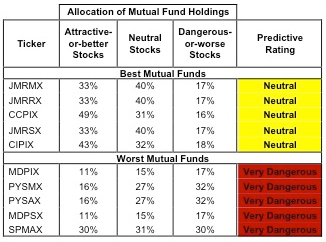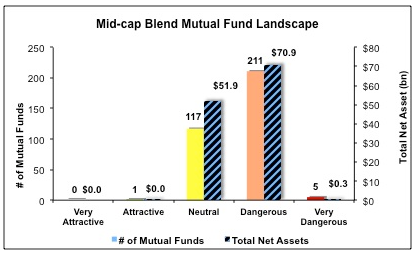The mid-cap blend style ranks ninth out of the twelve fund styles as detailed in my style rankings for ETFs and mutual funds. It gets my Dangerous rating, which is based on aggregation of ratings of 17 ETFs and 334 mutual funds in the mid-cap blend style as of October 22, 2012.
Figures 1 and 2 show the five best and worst-rated ETFs and mutual funds in the style. Not all mid-cap blend style ETFs and mutual funds are created the same. The number of holdings varies widely (from 28 to 3,076), which creates drastically different investment implications and ratings. The best ETFs and mutual funds allocate more value to Attractive-or-better-rated stocks than the worst, which allocate too much value to neutral-or-worse-rated stocks.
To identify the best and avoid the worst ETFs and mutual funds within the mid-cap blend style, investors need a predictive rating based on (1) stocks ratings of the holdings and (2) the all-in expenses of each ETF and mutual fund. Investors need not rely on backward-looking ratings.
Investors should not buy any mid-cap blend ETFs or mutual funds because none get an Attractive-or-better rating. If you must have exposure to this style, you should buy a basket of Attractive-or-better rated stocks and avoid paying undeserved fund fees. Active management has a long history of not paying off.
Figure 1: ETFs with the Best & Worst Ratings – Top 5

* Best ETFs exclude ETFs with NAV’s less than 100 million.
Sources: New Constructs, LLC and company filings
Five ETFs were excluded from Figure 1 because their total net assets (TNA) are below $100 million and do not meet our liquidity standards.
Figure 2: Mutual Funds with the Best and Worst Ratings – Top 5 
* Best mutual funds exclude funds with NAV’s less than 100 million.
Sources: New Constructs, LLC and company filings
Four mutual funds were excluded from Figure 2 because their total net assets (TNA) are below $100 million and do not meet our liquidity standards.
iShares Morningstar Mid Core Index Fund (JKG) is my top-rated mid-cap blend ETF and JPMorgan Trust I: JPMorgan Mid Cap Core Fund (JMRMX) is my top-rated mid-cap blend mutual fund. Both earn my Neutral rating.
Vanguard Extended Market ETF (VXF) is my worst-rated mid-cap blend ETF and Saratoga Advantage Trust: Mid Capitalization Portfolio (SPMAX) is my worst-rated mid-cap blend mutual fund. VXF earns my Dangerous rating, while SPMAX earns my Very Dangerous rating.
Figure 3 shows that 537 out of the 2,520 stocks (over 29% of the total net assets) held by mid-cap blend ETFs and mutual funds get an attractive-or-better rating. However, no mid-cap blend ETFs and only one out of 334 mid-cap blend mutual funds (less than 1% of total net assets) get an attractive-or-better rating.
The takeaways are: mutual fund managers allocate too much capital to low-quality stocks and mid-cap blend ETFs hold poor quality stocks.
Figure 3: Mid-cap Blend Style Landscape For ETFs, Mutual Funds & Stocks
Sources: New Constructs, LLC and company filings
As detailed in “Cheap Funds Dupe Investors,” the fund industry offers many cheap funds but very few funds with high-quality stocks, or with what I call good portfolio management.
Investors need to tread carefully when considering mid-cap blend ETFs and mutual funds, as no ETFs and only one mutual fund in the mid-cap blend style allocate enough value to attractive-or-better-rated stocks to earn an attractive rating. Investors would be better off focusing on individual stocks instead.
Advance Auto Parts, Inc. (AAP) is one of my favorite stocks held by mid-cap blend funds. It receives my Very Attractive rating. Much like the discounts AAP offers to their customers, shares in AAP currently trade at a bargain price. AAP trades at a price-to-economic book ratio of .58. This is the lowest P/EBV assigned to AAP in the 11 years of history in our model. The market is concerned with AAP’s Q2 revenue contraction and fears that an improving economy will demand more new cars and fewer repairs on old ones.
Yet, as he often does, Mr. Market has overreacted as AAP’s P/EBV assumes a 42% permanent decline in after-tax operating earnings (NOPAT). As the market has grown more pessimistic, AAP has grown more profitable. AAP’s economic earnings have never been higher. In 2011 AAP achieved an 11.4% economic earnings margin; this places AAP in the 90th percentile of our coverage universe. This combination of a cheap stock price and improving profitability makes AAP a Very Attractive stock.
The Macerich Company (MAC) is one of my least favorite stocks held by mid-cap blend funds. It receives my Dangerous rating. MAC’s current stock price (~$58.91/share) implies that it will grow its after-tax operating earnings (NOPAT) at 12%, compounded annually, for the next fourteen years. This performance is required to simply justify the current stock price. If this growth is fueled by acquisitions, it is unlikely to create value for shareholders. If the past is any indicator, acquisitions-driven growth will destroy value for shareholders.
Here is why: though the company grew operating profits by over 100% since 2000, its invested capital grew by more than twice as much (234%) during the same time. When the balance sheet grows faster than earnings, returns on invested capital decline and shareholder value is destroyed. Not surprisingly, MAC has had negative economic earnings every year since 2000. Not all growth is created equal especially when investment bankers are involved. Investors should avoid this Dangerous stock.
Figures 4 and 5 show the rating landscape of all mid-cap blend ETFs and mutual funds.
Our style rankings for ETFs and mutual funds report ranks all styles and highlights those that offer the best investments.
Figure 4: Separating the Best ETFs From the Worst Funds 
Sources: New Constructs, LLC and company filings
Figure 5: Separating the Best Mutual Funds From the Worst Funds
Sources: New Constructs, LLC and company filings
Disclosure: I receive no compensation to write about any specific stock, sector, style or theme.
- English (UK)
- English (India)
- English (Canada)
- English (Australia)
- English (South Africa)
- English (Philippines)
- English (Nigeria)
- Deutsch
- Español (España)
- Español (México)
- Français
- Italiano
- Nederlands
- Português (Portugal)
- Polski
- Português (Brasil)
- Русский
- Türkçe
- العربية
- Ελληνικά
- Svenska
- Suomi
- עברית
- 日本語
- 한국어
- 简体中文
- 繁體中文
- Bahasa Indonesia
- Bahasa Melayu
- ไทย
- Tiếng Việt
- हिंदी
Best And Worst ETFs And Mutual Funds: Mid-Cap Blend Style
Published 10/23/2012, 07:10 AM
Updated 07/09/2023, 06:31 AM
Best And Worst ETFs And Mutual Funds: Mid-Cap Blend Style
3rd party Ad. Not an offer or recommendation by Investing.com. See disclosure here or
remove ads
.
Latest comments
Install Our App
Risk Disclosure: Trading in financial instruments and/or cryptocurrencies involves high risks including the risk of losing some, or all, of your investment amount, and may not be suitable for all investors. Prices of cryptocurrencies are extremely volatile and may be affected by external factors such as financial, regulatory or political events. Trading on margin increases the financial risks.
Before deciding to trade in financial instrument or cryptocurrencies you should be fully informed of the risks and costs associated with trading the financial markets, carefully consider your investment objectives, level of experience, and risk appetite, and seek professional advice where needed.
Fusion Media would like to remind you that the data contained in this website is not necessarily real-time nor accurate. The data and prices on the website are not necessarily provided by any market or exchange, but may be provided by market makers, and so prices may not be accurate and may differ from the actual price at any given market, meaning prices are indicative and not appropriate for trading purposes. Fusion Media and any provider of the data contained in this website will not accept liability for any loss or damage as a result of your trading, or your reliance on the information contained within this website.
It is prohibited to use, store, reproduce, display, modify, transmit or distribute the data contained in this website without the explicit prior written permission of Fusion Media and/or the data provider. All intellectual property rights are reserved by the providers and/or the exchange providing the data contained in this website.
Fusion Media may be compensated by the advertisers that appear on the website, based on your interaction with the advertisements or advertisers.
Before deciding to trade in financial instrument or cryptocurrencies you should be fully informed of the risks and costs associated with trading the financial markets, carefully consider your investment objectives, level of experience, and risk appetite, and seek professional advice where needed.
Fusion Media would like to remind you that the data contained in this website is not necessarily real-time nor accurate. The data and prices on the website are not necessarily provided by any market or exchange, but may be provided by market makers, and so prices may not be accurate and may differ from the actual price at any given market, meaning prices are indicative and not appropriate for trading purposes. Fusion Media and any provider of the data contained in this website will not accept liability for any loss or damage as a result of your trading, or your reliance on the information contained within this website.
It is prohibited to use, store, reproduce, display, modify, transmit or distribute the data contained in this website without the explicit prior written permission of Fusion Media and/or the data provider. All intellectual property rights are reserved by the providers and/or the exchange providing the data contained in this website.
Fusion Media may be compensated by the advertisers that appear on the website, based on your interaction with the advertisements or advertisers.
© 2007-2024 - Fusion Media Limited. All Rights Reserved.
